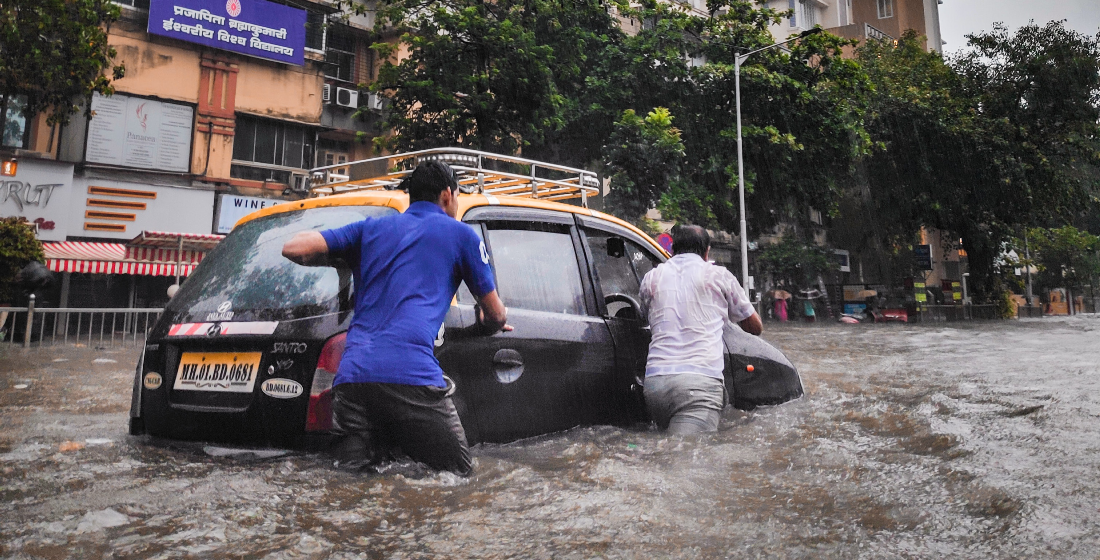Adaptation finance steps out of the shadows
Flying under the radar at the recent COP26 summit, finance for climate adaptation is finally receiving its due attention in the climate-action agenda.

As the embers of the COP26 UN Climate Conference in Glasgow slowly fade, a veritable potpourri of scientists, commentators and self-proclaimed experts have been thumbing through the fresh ink of the Glasgow Climate Pact to make sense of all the new commitments to climate action. But lost amongst all the furore around the new pledges – or the lack thereof – to limit greenhouse gas emissions and mitigate climate change was an equally important development: Glasgow heralded an array of new pledges aimed at helping the world adapt to the effects of climate change that are already coming our way.
The provision of finance to help the most affected countries adapt to climate change is always a contentious topic at COP summits. Back in 2009, developed nations agreed to provide $100 billion annually to help their developing counterparts mitigate and adapt to the effects of climate change. This target, sadly, has not been met – reaching only, by the last count, $80 billion in 2019. And perhaps more worryingly, only 25% of that amount has gone to adaptation initiatives – despite UN Secretary-General António Guterres and others repeatedly calling for the need for climate finance to be split 50/50 between adaptation and mitigation.
“The provision of adaptation finance as a proportion of climate finance has so far been inadequate. Frankly, there’s much more to do,” said COP26 President Alok Sharma. “[That’s] been a big focus of the UK’s COP26 presidency and there has definitely been some progress, with the key developed countries increasing their support for adaptation finance [over the course of the summit].”
Sharma was speaking on the panel, Financing a More Resilient World, which brought together representatives of key climate-finance stakeholders, from governments, development banks, and the private sector, to discuss the latest progress made in the adaptation-finance arena.
Money on the table
For all its other shortcomings, the Glasgow Climate Pact made some substantial strides to resolve the adaptation-finance shortfall. That included an unprecedented goal for developed countries to double the funding provided to developing countries for adaptation by 2025, taking the annual figure to approximately $40 billion – widely viewed as one of the summit’s key successes.
More than $450 million was committed for “locally-led adaptation approaches”, and the Adaptation Fund raised a record $356 million in new pledges. Glasgow also saw donors pledge $413 million to the Least Developed Countries Fund, which, hosted by the Global Environment Facility, is the only climate resilience fund that exclusively targets least developed countries.
Additionally, there was debate among countries over a carbon trading tax intended to fund adaptation in developing nations. Although bilateral trading in carbon offsets will not be subject to the levy, there will be a separate international system for issuing offsets, on which a 5% tax will go to adaptation.
Donors: regional risk pools and doubling down
“The needs for adaptation are really high, and keep increasing as climate impacts worsen. Fortunately, while the needs are growing, awareness and support are increasing too,” said Jochen Flasbarth, Germany’s State Secretary at the Ministry for Environment, Nature Conservation and Nuclear Safety.
Exemplifying what donor countries have been doing to increase adaptation-finance provision, Flasbarth pointed to how the Inter-Resilience Climate Partnership members have been supporting regional risk pools like the Pacific Catastrophe Risk Insurance Company and the Caribbean Catastrophe Risk Insurance Facility. “Risk pools like these are one of the key tools that are increasing resilience and are a very good way of encouraging a proactive approach to disaster risk management and financing,” said Flasbarth, adding that Germany would commit another €10 million to both funds this year.
As well as reacting better to disasters, Flasbarth highlighted the need to reduce exposure and vulnerability in advance through adaptation action. “The need for adaptation measures is increasing worldwide, which requires considerably more financial means. We know that adaptation finance still falls short of what is necessary.” She subsequently announced that Germany would increase its climate finance pledge from €4 billion to €6 billion from budget sources by 2025 at the latest, and urged other developed nations to follow suit.
Furthermore, besides the need for rising availability of finance for adaptation, access to it also remains a major challenge. Studies suggest that only a fraction of climate finance is spent locally. “Even if the funds are available they must also be accessible and get to where they are needed the most. We have to address these challenges more strongly by facilitating access to climate finance and by helping to improve the capacities of our partners to manage these funds,” concluded Flasbarth.
MDBs: fostering resilience with innovative financial mechanisms
From the perspective of multilateral development banks (MDBs), one of the main priorities is to “integrate the management of climate risk and disasters with the whole agenda of adaptation and resilience”, said Dr Juan Pablo Bonilla, manager, Climate Change and Sustainable Development Sector, Inter-American Development Bank (IADB). Bonilla provided three examples of how MDBs can innovate from a financial-mechanism perspective to “integrate climate disasters with the role of biodiversity and nature as part of the resilience we need to build at the national level, at the sub-national level and as part of private-sector development”.
The IADB recently completed an assessment of the institutional and financial capacity of its member governments relating to natural disasters and created the iGOPP index of governance and public-policy capacity to address climate disasters. “As part of that exercise, we found out that we needed to develop an instrument directly for the ministers of finance of the region to respond to disasters,” said Bonilla. The development bank therefore created the Contingent Credit Line Facility to provide ministers of finance with an ongoing credit line available to them for when a climate disaster strikes. The governments do not have to pay any interest or fees until they use the facility, which has already provided $1.9 billion to 14 countries.
The IADB also created the Hurricane+, a clause that the bank will include in its lending allowing for the deferral of principal payments for two years, which Bonilla says “will create fiscal space for climate events and disaster response”. The IADB is in negotiations with Barbados, Bahamas, Jamaica and the Dominican Republic to include this clause in their financings.
“But we needed to do the same in the private sector,” added Bonilla. To do that, IDB Invest, the private sector arm of IADB, created the El Niño+. Seeing the impact of the El Niño weather pattern on fisheries in Peru, IDB Invest created a clause to reschedule loan capital payments for private sector companies during the month of the respective climate impact, “allowing them the opportunity to recover”, as Bonilla put it. Having already used the El Niño financial resilience clause for three operations (the last one approved in August), IDB Invest has expanded the El Niño financial resilience clause to also help private sector companies recover from the impacts of the La Niña weather pattern, flooding, droughts, and fires.
In order to build further climate resilience in the region, the IADB also has also invested heavily in its portfolio nature-based solutions, which now encompasses 28 operations valued at over $800 million. To that end, the development bank has teamed up with the UK and French governments to create the Natural Capital Lab, which pilots low-carbon solutions such as mangroves forests at coastal cities.
“We have good examples at the national level like the Roof to Reef Programme in Barbados and the decarbonisation plan we’ve supported in Costa Rica,” says Bonilla. “At the sub-national level, we are developing the first loan precedent for Barranquilla (Colombia), as part of the Biodiverse Cities Programme of Colombia’s President Duque, to finance mangroves, urban wetlands and different climate resilience options to integrate biodiversity and nature-based solutions into resilience to climate change.”
In Chile, the bank has approved a national programme for informal neighbourhoods, which includes mapping the natural disaster risks and the potential responses, with an emphasis on nature-based solutions. IDB Invest has also recently announced Latin America’s first blue bond, aimed at supporting private sector companies linked to oceans and the contamination of water.
Bonilla, finally, urged other MDBs to expand access to concessional resources available for blended finance instruments. “We have proved, as MDBs, the importance of blended financing for decarbonisation. And now we need to do the same for adaptation and resilience,” he concluded.
The private sector: redirecting the invisible hand
Speaking on behalf of the private sector, John Hanley, CEO of insurance behemoth Willis Towers Watson, said: “In this climate emergency, [Adam Smith’s] invisible hand needs to be redirected. Since Paris, we’ve been working to guide the financial system’s invisible hand to shape a resilient future. An economy that protects our investments from climate will also protect the homes of our citizens, their crops and their livelihoods.”
Hanley flagged four initiatives that are “making some real impact”. The first is a directive that arose directly from the Paris Agreement: the Insurance Development Forum (IDF) was launched at COP21, co-chaired by the insurance industry, the UNDP, and the World Bank. With the support of the German government, the IDF is supporting disaster risk finance across 20 developing countries as part of the Insure Resilience target to protect 500 million people from climate risks by 2025. Hanley took the moment to announce the latest IDF development, a formal partnership focused on the most vulnerable countries: the IDF will support the V20 group of vulnerable countries to inform resilience through the Global Risk Modelling Alliance.
The second initiative is aimed at advancing climate risk modelling on behalf of all countries. Said Hanley: “There’s an information failure that exists: we don’t have the data or analytics to properly understand climate risk, and that’s part of what’s driving the climate resilience emergency.” Another new partnership, the Global Resilience Index Initiative, supported by the UN Office for Disaster Risk Reduction and others, will provide climate resilience data analytics for all by COP27.
The third initiative, the Co-Initiative for Climate Resilient Investment (CCRI), relates to investment in infrastructure. “This was launched at the UN Climate Summit in 2019 and we come to COP26 with 120 members and $120 trillion of assets under advisement – we represent governments, we represent the financial sector, engineers and many other organisations,” said Hanley. The CCRI aims to deliver practical solutions for better pricing of climate risks in investment decision-making. That encompasses two key areas of decision making: national planning for systemic resilience, and asset design and structuring.
“All CCR solutions recognise the challenges faced by SIDS (Small Island Developing States) when it comes to physical climate risks,” said Hanley. “So we’ve created a partnership with the government of Jamaica, with the support of the UK government and the Green Climate Fund, and we’re going to launch a tool that allows for the identification of the projects most capable of protecting the economic, social and ecosystem value in Jamaica over the next 20 years. We plan to roll this tool out in many other countries in the years to come.”
The final initiative Hanley flagged was aimed at governance. “To mainstream progress, regulation of financial markets requires climate risks to be disclosed, accounted and managed,” he explained. To that end, at the summit, the Cambridge Institute for Sustainability Leadership teamed up with insurers, regulators and other organisations to issue a call to action to include 20 actions to apply climate resilience mandates across the financial system.
“So in closing, I propose an answer to the question of ‘what’s next?’,” said Hanley, wrapping up the discussion. “That here in Glasgow, with the inspiration of its economic heritage, we declare a new financial order, one that builds upon the economic influence of this place and forges a new role for the invisible hand to guide a resilient and prosperous future.”





